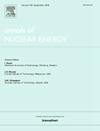Early fault detection method for nuclear power plants based on sparse denoising autoencoder and kernel principal component analysis
IF 1.9
3区 工程技术
Q1 NUCLEAR SCIENCE & TECHNOLOGY
引用次数: 0
Abstract
Effective fault detection technology is of great significance to the safety and economy of nuclear power plants (NPPs). To accurately identify early faults in NPPs, this study proposes a novel fault detection method based on sparse denoising autoencoder (SDAE) and kernel principal component analysis (KPCA). First, the operating data of NPPs is collected by numerous sensors, and the operating parameters are grouped according to physical properties. Then, the corresponding fault detection model is established according to each parameter group, and each detection model consists of the SDAE and KPCA. The case study evaluated four accident scenarios (LOCA, SLBIC, FHAIC, FHAIAB) across two development degrees (0–1 % and 0–0.1 %). The proposed method achieved fault detection rates of 99.07 %, 95.20 %, 99.73 %, and 99.60 % for the 0–1 % degree with zero false alarms. Even for the subtler 0–0.1 % degree, it maintained a 94.84 % average detection rate and no false alarms. Compared to traditional methods, its average fault detection rate was higher than that of PCA and KPCA by 62.9 % and 32.4 % (0–1 % degree), and by 89.5 % and 88 % (0–0.1% degree), demonstrating its potential application value in NPPs.
基于稀疏去噪自编码器和核主成分分析的核电厂早期故障检测方法
有效的故障检测技术对核电厂的安全、经济运行具有重要意义。为了准确识别核电机组早期故障,提出了一种基于稀疏去噪自编码器(SDAE)和核主成分分析(KPCA)的新型故障检测方法。首先,通过多个传感器采集核电站运行数据,并根据物理性质对运行参数进行分组。然后,根据每个参数组建立相应的故障检测模型,每个检测模型由SDAE和KPCA组成。案例研究评估了四个事故场景(LOCA, SLBIC, FHAIC, FHAIAB)在两个发展程度(0 - 1%和0 - 0.1%)。该方法在0 ~ 1%的故障检测率分别为99.07%、95.20%、99.73%和99.60%,且无虚警。即使在0 - 0.1%的温度下,也能保持94.84%的平均检出率,无误报。与传统方法相比,该方法的平均故障检出率分别比PCA和KPCA方法高62.9%和32.4%(0 ~ 1%度),比PCA和KPCA方法高89.5%和88%(0 ~ 0.1%度),显示了其在核电站中潜在的应用价值。
本文章由计算机程序翻译,如有差异,请以英文原文为准。
求助全文
约1分钟内获得全文
求助全文
来源期刊

Annals of Nuclear Energy
工程技术-核科学技术
CiteScore
4.30
自引率
21.10%
发文量
632
审稿时长
7.3 months
期刊介绍:
Annals of Nuclear Energy provides an international medium for the communication of original research, ideas and developments in all areas of the field of nuclear energy science and technology. Its scope embraces nuclear fuel reserves, fuel cycles and cost, materials, processing, system and component technology (fission only), design and optimization, direct conversion of nuclear energy sources, environmental control, reactor physics, heat transfer and fluid dynamics, structural analysis, fuel management, future developments, nuclear fuel and safety, nuclear aerosol, neutron physics, computer technology (both software and hardware), risk assessment, radioactive waste disposal and reactor thermal hydraulics. Papers submitted to Annals need to demonstrate a clear link to nuclear power generation/nuclear engineering. Papers which deal with pure nuclear physics, pure health physics, imaging, or attenuation and shielding properties of concretes and various geological materials are not within the scope of the journal. Also, papers that deal with policy or economics are not within the scope of the journal.
 求助内容:
求助内容: 应助结果提醒方式:
应助结果提醒方式:


